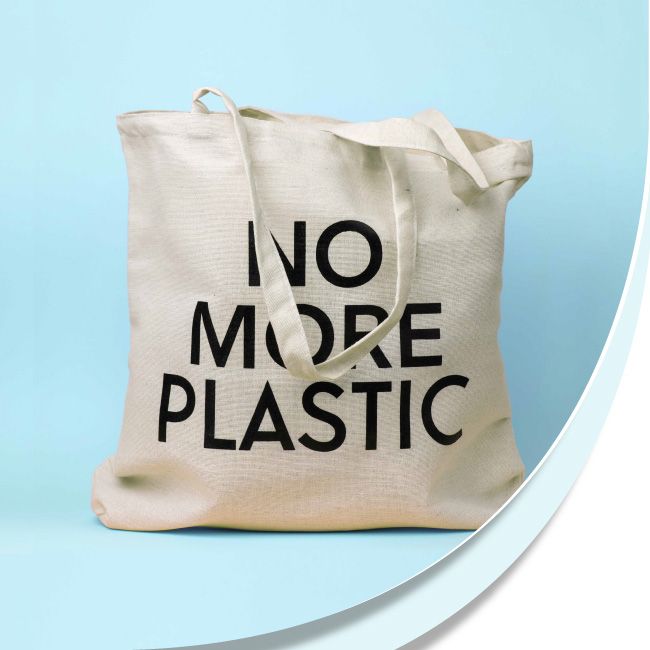
Replacing plastic in business: how to do better without disrupting everything
It is entirely possible to significantly reduce plastic use in a company — provided there is a clear strategy, low-impact materials are selected, and teams are gradually involved. Fossil-based plastic will not disappear overnight, but certified, traceable, and professional-grade alternatives already exist today thanks to BioApply.
Key Takeaways
-
Fossil-based plastic harms both brand image and the environment.
-
BioApply offers concrete, certified, and traceable alternatives: compostable bioplastics, kraft paper, TreeTote® wood fiber, BioPaper.
-
An internal audit is essential to prioritize the most effective replacements.
-
Recycling helps, but it cannot replace reduction at the source.
-
BioApply supports businesses with tailor-made, certified, and traceable solutions via Respect Code.
Why Replace Plastic in Business?
Reducing plastic use helps limit ecological impact, comply with regulatory requirements, and strengthen sustainable positioning. Fossil-based plastic is one of the most persistent and polluting materials: it fragments, contaminates ecosystems over the long term, and takes centuries to decompose.
Certified compostable bioplastics provide a concrete and traceable answer, especially when paired with structured composting systems. BioApply is committed to offering materials with a certified and verifiable end of life.
What Should You Know Before Starting?
Before making changes, it is essential to identify which plastics are used: their type, function, frequency, and lifespan.
An audit of your packaging, supplies, and consumables allows you to map current usage and build a realistic, step-by-step replacement plan.
Ask Yourself the Right Questions:
-
Does the plastic serve a technical function or a purely aesthetic one?
-
Can some uses be eliminated altogether without replacement?
-
What is the actual lifespan of these items?
Start with visible, low-priority applications such as bags, cups, and secondary packaging. Replacing them with certified and traceable compostable materials, such as those offered by BioApply, delivers measurable environmental benefits within just a few months.
Can Plastic Be Completely Replaced in Business?
Not always 100%, but significant reduction is realistic.
In certain industries (healthcare, food, logistics), technical plastics remain necessary. However, in most contexts (offices, events, retail), a reduction of 70–90% is achievable.
The key is to target non-essential single-use plastics and replace them with certified compostable materials (e.g. OK Compost, EN 13432), or recyclable ones where local infrastructure allows.
What Are the Best Alternatives to Plastic?
Here are the most relevant solutions offered by BioApply:
-
Kraft paper and cardboard: recyclable, economical, customizable. Ideal for bags, parcels, and padding.
-
Certified compostable bioplastics: plant-based (from starch or sugarcane), certified OK Compost / EN 13432 for full biodegradation in industrial or home composting. BioApply offers compostable bags for biowaste or transport, with Respect Code traceability.
-
Wood fiber: used in BioApply’s TreeTote® range. A local and renewable alternative to cotton, reducing water consumption by over 90% compared to organic cotton. 100% compostable and recyclable, PEFC certified.
-
Reusable textiles: jute, recycled cotton, or locally recycled polyester where circularity is ensured. Suitable for delivery bags, covers, and tote bags.
-
Functional anti-moisture paper: BioApply’s BioPaper replaces plastic-coated packaging for greasy or damp contents. 100% compostable, no plastic lamination.
How to Replace Plastic Effectively
-
Target quick wins: focus on single-use items that are easy to replace.
-
Choose the right partners: BioApply provides certified and traceable solutions.
-
Engage your teams: success depends on employee buy-in.
-
Measure results: track reductions in plastic use and adjust accordingly.
-
Communicate your actions: share efforts and results with clients and partners.
And What About Plastic Recycling?
Useful, but insufficient.
In Switzerland, less than 15% of plastics are recycled. Incineration remains the norm and releases harmful emissions. Many plastics are non-recyclable or contaminated.
This is why source reduction and the use of certified compostable materials with a clearly defined, traceable end of life are more coherent solutions. BioApply ensures traceability of its products via respect-code.org.
Conclusion
Replacing plastic is not utopia — it is already a reality adopted by hundreds of businesses supported by BioApply.
It is not a matter of perfection, but of measurable, verifiable progress.
Alternatives exist: compostable, traceable, and tailored to professional needs. BioApply supports this transition with customized, certified, and technically proven solutions.
FAQs (Updated)
What materials can replace plastic?
Kraft paper, cardboard, wood fiber (TreeTote®), certified compostable bioplastics.
What is the difference between bioplastic and compostable plastic?
Bioplastic is plant-based but not always compostable. Compostable plastic is designed to fully break down under specific conditions and is certified (OK Compost, EN 13432).
How can businesses recycle plastic?
By separating waste streams, partnering with certified recyclers, and above all by reducing non-recyclable plastics at the source.
Why is so little plastic recycled in Switzerland?
Energy-recovery incineration is considered more cost-effective, particularly for contaminated or composite plastics.
When is plastic still useful?
In certain critical contexts (medical, food), although compostable alternatives are emerging even here.
Will compostable bioplastics replace conventional plastic?
They are gaining ground, driven by regulation and demand. Their adoption depends on controlled end-of-life management and a strong regulatory framework.
